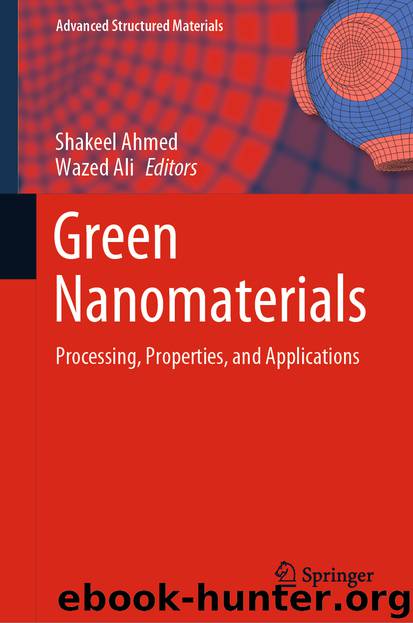Green Nanomaterials by Shakeel Ahmed & Wazed Ali

Author:Shakeel Ahmed & Wazed Ali
Language: eng
Format: epub
ISBN: 9789811535604
Publisher: Springer Singapore
4 Future Perspectives
The continuous growth of research publications on the conversion of renewable sources into carbon dots for numerous applications indicating the notable importance of these unique materials in the society as well as research world. Even though numerous synthetic methods are possible, still now only few methods were explored for the utilization of renewable sources. This clearly indicates that finding out the proper synthetic methods can give more heights in the area of preparation of C-dots from renewable sources. Development of processes for the preparation of renewable source-derived C-dots by obeying green chemistry aspects can create a global market for them. In general, hydrothermal treatment is the preferred approach due to its easy, rapid, and scalable possibilities. Though microwave and ultrasonication are reported for the rapid preparation of C-dots, their own demerits such as energy-intensive as well as limitations in scalable processes make them to occupy the next place to hydrothermal processes.
Only selective renewable sources are till now explored in this area of research and open the wide scope for variety of renewable sources which differ from one source to another (especially plant resources due to climate issues and soil effects). In these aspects, regional-based resources (mainly non-edibles) can be effectively used for the conversion to C-dots, and thus, more opportunities can be created for agriculture. The main advantage of C-dots is that they can be also collected from carbon materials by applying simple physical techniques such as extraction methods. This approach is making more lanes in the bio-carbon research area that can overcome the landfilling issues of agricultural residues and can directly support the growth of plant cultivations. In recent years, marine-based resources are gaining more interest in bio-based materials preparation but only restricted literature is available for C-dots using few of the marine sources. Due to their structural aspects and also the presence of multiple components, most of the marine sources can end up in functionalized C-dots in one-step approach. Due to the noticeable development in bioengineering, one can alter the metabolites of the plants (including some marine sources) that can lead to completely different C-dots compared to original plants.
Developing eco-friendly processes with improved quantum yield is the initial task in the use of renewable sources. The next challenge present in this area of research is to prepare the completely bio-based greener CDs without using any other additives with high performances toward the targeted applications. Developing eco-friendly processes for surface passivation/functionalization without harsh synthetic conditions is the next challenge that comes forward in this area. Though most of the bio-derived C-dots were used for sensing purposes due to their fluorescence nature, selective sensor of specific components in the real systems is the main hurdle that presents in nowadays. In general, bio-derived C-dots are non-harmful to human/nature; their lifetime and decay mechanisms have to be studied well that can promote their role more in the biomedicine fields. Finding out the new applications for bio-derived C-dots can create a rapid commercial interest for these materials in the society. Additionally,
Download
This site does not store any files on its server. We only index and link to content provided by other sites. Please contact the content providers to delete copyright contents if any and email us, we'll remove relevant links or contents immediately.
| Automotive | Engineering |
| Transportation |
Whiskies Galore by Ian Buxton(41537)
Introduction to Aircraft Design (Cambridge Aerospace Series) by John P. Fielding(32893)
Small Unmanned Fixed-wing Aircraft Design by Andrew J. Keane Andras Sobester James P. Scanlan & András Sóbester & James P. Scanlan(32579)
Craft Beer for the Homebrewer by Michael Agnew(17938)
Turbulence by E. J. Noyes(7716)
The Complete Stick Figure Physics Tutorials by Allen Sarah(7148)
Kaplan MCAT General Chemistry Review by Kaplan(6603)
The Thirst by Nesbo Jo(6446)
Bad Blood by John Carreyrou(6283)
Modelling of Convective Heat and Mass Transfer in Rotating Flows by Igor V. Shevchuk(6230)
Learning SQL by Alan Beaulieu(6042)
Weapons of Math Destruction by Cathy O'Neil(5843)
Man-made Catastrophes and Risk Information Concealment by Dmitry Chernov & Didier Sornette(5664)
Digital Minimalism by Cal Newport;(5396)
Life 3.0: Being Human in the Age of Artificial Intelligence by Tegmark Max(5194)
iGen by Jean M. Twenge(5166)
Secrets of Antigravity Propulsion: Tesla, UFOs, and Classified Aerospace Technology by Ph.D. Paul A. Laviolette(5002)
Design of Trajectory Optimization Approach for Space Maneuver Vehicle Skip Entry Problems by Runqi Chai & Al Savvaris & Antonios Tsourdos & Senchun Chai(4847)
Electronic Devices & Circuits by Jacob Millman & Christos C. Halkias(4753)
